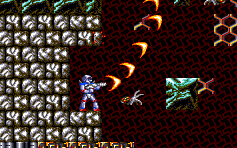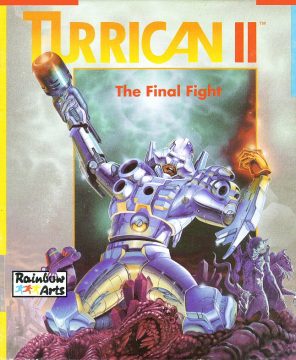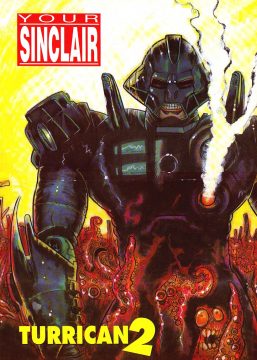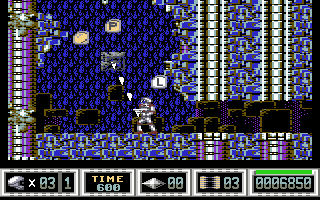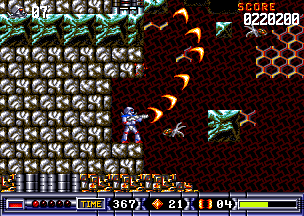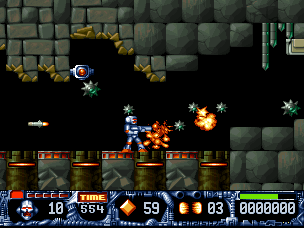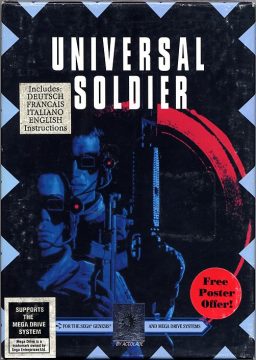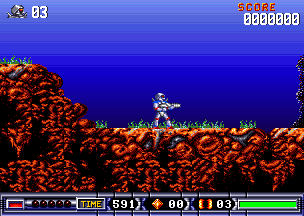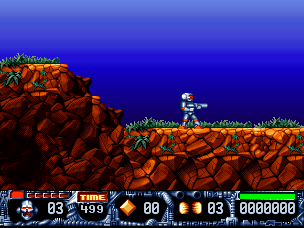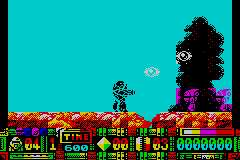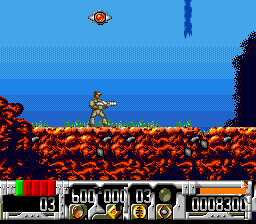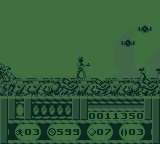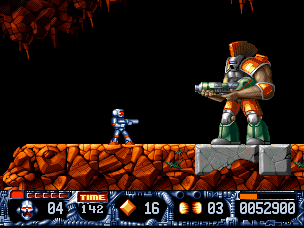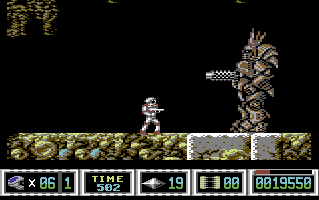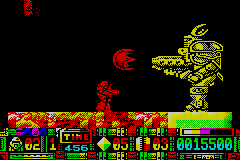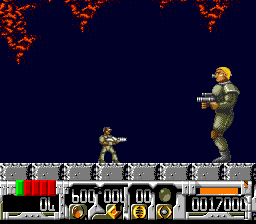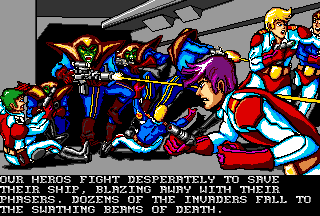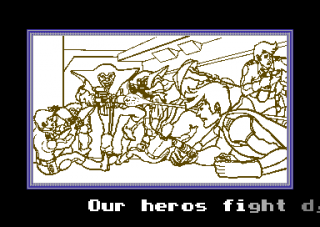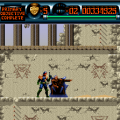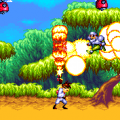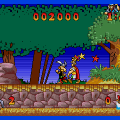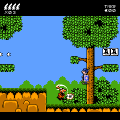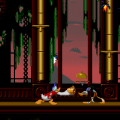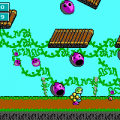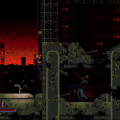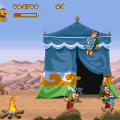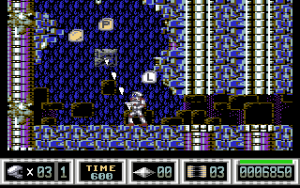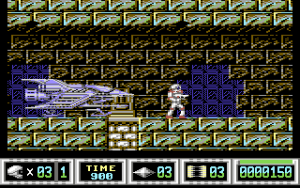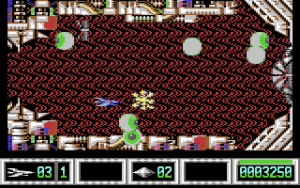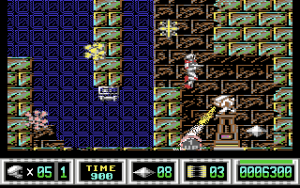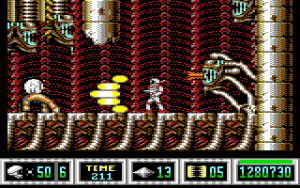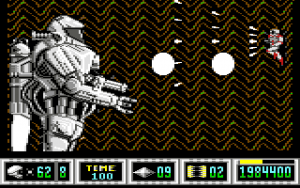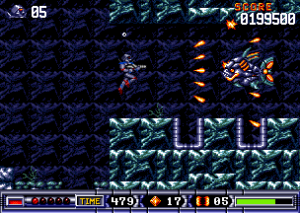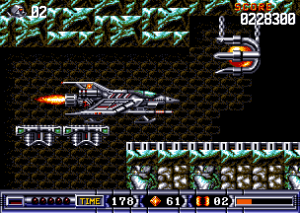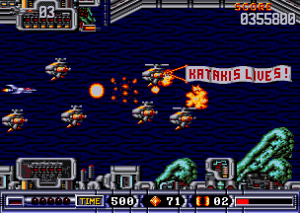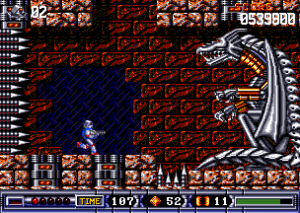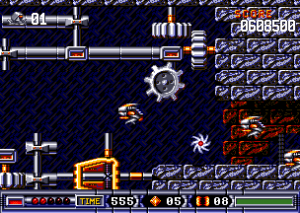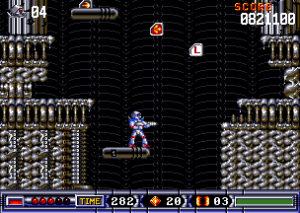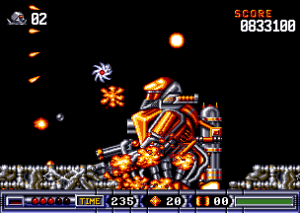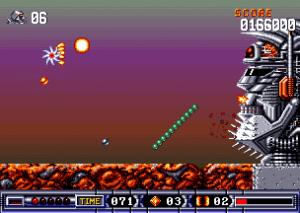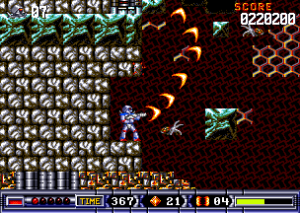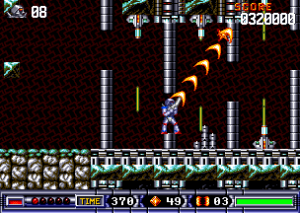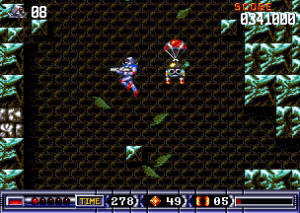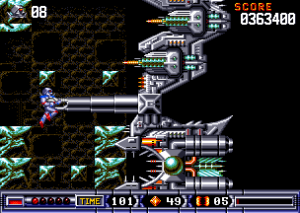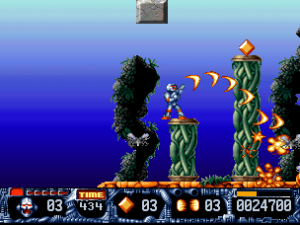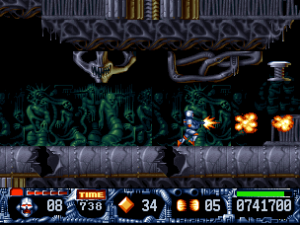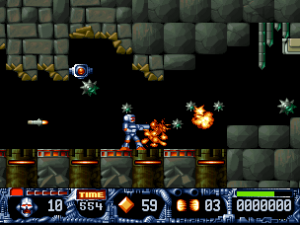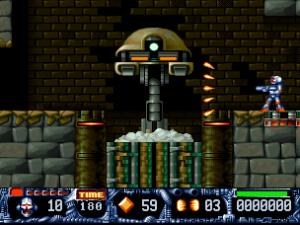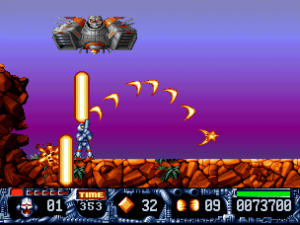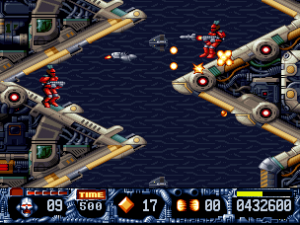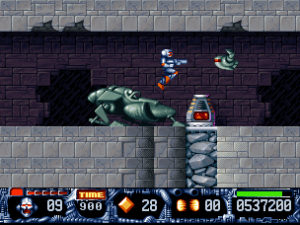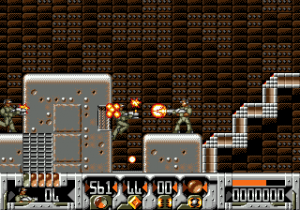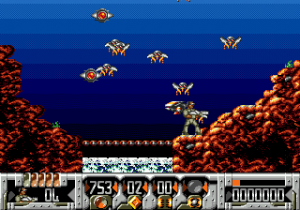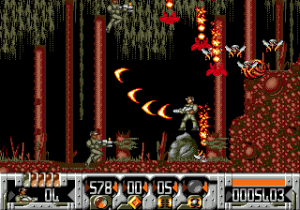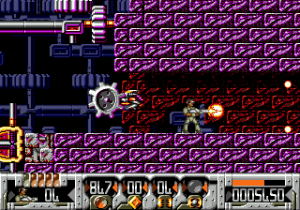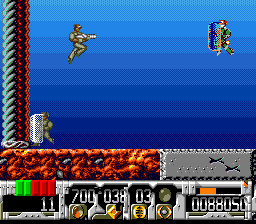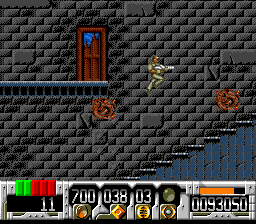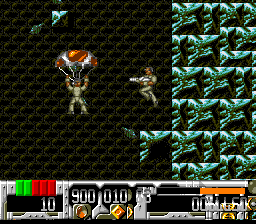- Turrican
- Turrican II: The Final Fight
- Super Turrican
- Mega Turrican / Turrican III
- Super Turrican
- Super Turrican 2
After Turrican’s great success, a sequel was only a matter of time. And when it arrived, it drastically improved on the original in every way possible. Turrican II is to Turrican what Sonic 2 is to its predecessor: it takes the original’s premises to a bigger scope. Story scenes were distinctly lacking in the first game, but this time players are given a bit of background in a vaguely anime-inspired intro: the UPFF Forces ship Avalon 1 is attacked by the mutant army of “The Machine,” a mighty cyborg warlord. All the crew is killed except for Bren McGuire, who is now introduced as the series hero. The only one left to wear the Turrican Assault Suit, Brent goes to avenge his comrades and save the universe from The Machine’s threat.
Turrican II refines the gameplay as well: a third mode for the main rifle is added, the Rebound, whose shots bounce off and split in two when they hit a wall. The grenades are gone forever, while the mines became usable during Gyroscope mode only (until then, the it used the same weapons used in the standard form). The Wheel is now accessible without restrictions, and able to unleash a new spectacular “smart bomb” attack that destroys everything on screen; it actually ends up a bit overpowered this way, as its completely invincible and it’s easy to change into it at any given time (at least while standing on solid ground). Thanks to the streamlining of weapon systems, however Turrican II wasn’t as dependent on the keyboard anymore, only relying on the Spacebar in addition to the Joystick. Moreover, jumping was made easier, and controls are smoother in general. Going back to the first game after playing Turrican II actually feels a bit awkward. Turrican II is also larger in size compared to its predecessor, featuring enormous levels of a scope never seen before.
The sheer amount of different elements to discover rivals that of Miyamoto’s best games – and some ideas were certainly inspired by Nintendo’s mastermind. The standard walker enemies now get squashed when jumped on and run away in fright, plants that grow rapidly until the top of the screen (and can actually be kept growing by going up, opening up ways to more secret areas) and at one point one has to get up a well by timing jumps to gusts of wind. At the midway point of the adventure, Brent McGuire boards on a space ship and the game suddenly turns into a shoot’em up for three stages. These are horizontal scrolling and they do even include a section with increasing speed a la Gradius II, and there’s also a funny shout-out to Trenz’ Katakis. This twist shocked many players back then; the shoot-em-up section is so much better than the jetpack from the original Turrican, which was more or less built with the same engine as the rest of the game. This “mini game” alone would make for one of the best shoot-em-ups on the C64.
The Amiga version this time was started from the very beginning, and Factor 5 even managed to finish it before the 8-bit original. The Amiga designers were able to bring the environments alive with incredibly detailed graphics and impressive parallax scrolling. Especially the animations received a major upgrade – the player sprite now changes its stance every few degrees when firing the Lighning beam. Even the Atari ST version caught up a bit in this respect, now showing animated waterfalls. Factor 5 also added some new elements: The huge gun the first boss wields, for example, can now be abused as a platform when it stands still, and the reoccuring jetpack stage from the C64 is replaced with a sequence of rapid elevator platforms. Turrican II on the Amiga is definitely the most well remembered, though, and easily the high point of the whole series.
Last but certainly not least, Chris Huelsbeck composed his all-time masterpiece for this game. The Amiga’s sound capabilities were never used like this before; together with Jochen Hippel (Factor 5’s Atari ST musician), Huelsbeck created a routine that first allowed for 7-channel music on the Amiga, named 7-Voice. More than anything else, It’s the epic score that really makes Turrican II stand out from the other games, and the reason it’s the most beloved by fans. The beauty of these arrangements often goes beyond description. The repertoire ranges from theme songs so catchy they would make every 80s TV show proud to rocky tunes with frenetic basslines in the shooter stages. The music in the “HR Giger world” opens with nothing but eerie heart-beat drums and screeches, until a threatening, monotonous march kicks in.
Shortly later, Manfred Trenz completed his C64 version of Turrican II. This one is considered the most advanced game ever developed on C64, and in a sense it is also the title that concludes its commercial lifespan for the most part. It wasn’t as succesful as the first for the benefit of the Amiga version, but it pushes the 8-bit Commodore to its very limits in many ways. One of the shooter levels even has multi-layered parallax scrolling! The music for this version was composed by Markus Siebold, who would later also compose the music for Trenz’s final C64 shoot-em-up, Enforcer. Like in the first game, only some of the stages have music (mostly the shooter and jetpack ones). The biggest difference to its 16-bit counterpart was to bring back the jetpack from the first game where Amiga players had to climb a tower using moving platforms. The British 8-bit ports were done by Enigma Variations this time. The Amstrad CPC version is even faster and better than the first game, and even retains some of the parallax scrolling. The Spectrum port on the other hand is even more Spectrum-esque, meaning choppy as hell and full of glitchy-looking graphics.
Well knowing that it was the best game in their catalog, Rainbow Arts produced a late conversion to MS-DOS in 1995, programmed by a team called Sun-Project. Mechanically it is an exact reproduction of the Amiga game, retaining all the exact quirks and physical inaccuracies of the engine. On the surface, however, the graphics were completely redrawn. The pixel work is absolutely fantastic, with the exception of the Turrican sprite, which looks a bit dorky.
[Disenfranchised Ports] Universal Soldier – Genesis, Game Boy, SNES (1992)
If it weren’t for Jean-Claude Van Damme and this stupid movie, the Genesis would have goten all three main Turrican games. The Code Monkeys were in fact working to port Turrican II as well, but then someone at publisher Accolade had the big idea to transform Turrican II into a tie-in of Van Damme’s movie. And so they did. Suffering a fate similar but opposite to Contra’s (which was “robotized” as Probotector for the European releases), Turrican’s sprite was changed into a marine. Some enemies were changed as well (gruesome eyeballs-walking-on-fingers became mini tanks). All the bosses were replaced: instead of the wonderful big mech in the first stage or the gorgeous steel dragon one can enjoy an oversized Dolph Lundgren and tiny bosses that didn’t even have their hit boxes adjusted.
Whether the movie license or technical issues were the reason, at either rate the three shoot-em-up stages got cut from the port. The Monkeys replaced them with three original platforming stages to link the game to the atmosphere of the movie, at least in theory: a prelude in the Vietnam jungle, a fortress and a laughable motel and car junkyard. Certainly not by coincidence, these are the weakest three stages in the whole game.
While they were at it, Code Monkeys brought Universal Soldier to Game Boy as well. It’s about the same deal as the Game Boy Turrican. There also exists a working rom of Universal Soldier for SNES, also developed by the same team but never actually released. The audio sounds awfully worse than the Genesis version, and the button mapping is weird, too.
And so, the best Turrican ever never received a proper console port. The most sad part of this story is, the port was going pretty well: aside from the dual input method for the jump, the mechanics are intact and special weapon usage fixed. They also included a password system, but it makes things way too easy. Even the music does sound a lot better than Turrican on the Genesis. The sound test does include all the tracks, even the ones those from the excised stages. Since it comes from the bones of such a masterwork, even this travesty is not ultimately a terrible game. Accolade tried hard to destroy it, but beneath the facelift still pulses the heart of a classic.
Screenshot Comparisons
First Stage
Boss
Intro
